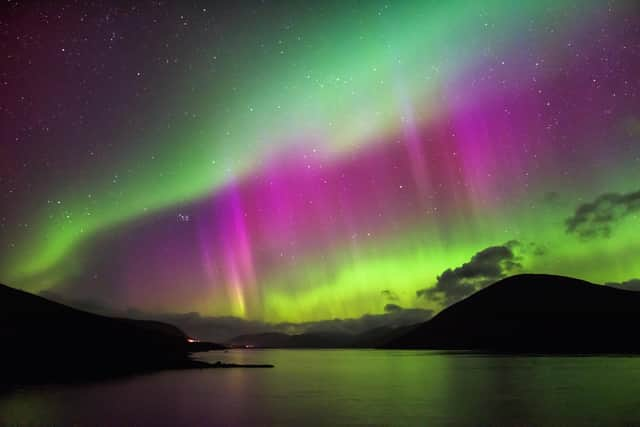Northern Lights tonight: experts issue ‘red alert’ for Aurora Borealis sightings in the UK - how to see them
and live on Freeview channel 276
The Northern Lights dazzled skies across the UK on Sunday night (April 23) due to a severe geomagnetic storm. The solar storm did not pose a threat to Earth but produced spectacular dancing lights in the skies of more regions than normal.
This resulted in thousands of people including those as far south as Cornwall having a front row seat as the vibrant colours of the Aurora Borealis danced across the night sky.
Advertisement
Hide AdAdvertisement
Hide AdHigh levels of magnetic activity around the British Isles were reported. AuroraWatch UK, a page run by astronomers at the University of Lancaster, has issued a "red alert" as of 7:54am BST, meaning aurora sightings across the UK are considered to be likely.
This isn’t the first time the UK has had a front row seat to the spectacular show. In February he Northern Lights were seen as far south as Cornwall and Dorset, however, many people missed out on the opportunity. As people wake up to stunning pictures of the Aurora Borealis many may feel disappointed at potentially missing out, again.
However, the statement added that the weather forecast is better for Monday and Monday night may be the best opportunity to get a good view of the Northern lights. Amid the reports, the Met Office confirmed the news in a statement that read: “In Scotland and northern England you may be able to spot the #Aurora Borealis tonight, though there will be too much cloud for most.”
The statement added: “Clearer skies tomorrow (Monday) night mean there will be a greater chance for some good views.”
Advertisement
Hide AdAdvertisement
Hide AdThe Aurora Borealis are not completely unheard of in British skies, however, experts say we are entering a period in which we can expect to have more opportunity to see them from the UK. This year we are closer to the solar maximum of cycle number 25, which means there will be a significant increase in solar activity compared to other years, with bigger displays on certain days.
The Northern Lights depend on solar activity that follows an 11 year-cycle. During the 11-year cycle the sun has less activity at the beginning and end of the cycle which is known as the solar minimum. There is also a solar maximum, which happens in the middle of the cycle and during which there is more significant activity, which increases the possibility of seeing more frequent geomagnetic storms and strong Northern Lights at lower latitudes.


Astronomers say that increased activity this far in advance of the solar maximum bodes well for future displays of the Northern Lights in Britain. Dr Robert Massey, deputy executive director of the Royal Astronomical Society, told The Independent: “The displays we have seen show that the sun is getting more active, and more than expected.
“There had been predictions that this cycle could be really weak but we’re two years away from the predicted maximum and there is more activity than was forecast, so the prospect looks good that more people will get to see displays of the Northern Lights.”
Advertisement
Hide AdAdvertisement
Hide AdSo, how can you spot the Northern Lights? Here’s a full breakdown of tips to give you the best chance of seeing them in the UK.


How to spot the Northern Lights
Seeing the Aurora Borealis is usually something people travel to the most northern parts of the world to see, like Iceland and Norway. However, it’s not uncommon to see them in the UK, they are often spotted in Scotland, and some parts of Northern England. But it is rare that people in southern England get such a vibrant show.
In order to have the best chance of seeing the light show, experts always recommend that stargazers should consult their weather forecast and set up camp somewhere far away from the light pollution of towns and cities. You need clear conditions, and to find a really dark part of your area to get a good look at them. So safety protocol, like not going alone, bringing a torch, and wrapping up warm is very much advised.
Comment Guidelines
National World encourages reader discussion on our stories. User feedback, insights and back-and-forth exchanges add a rich layer of context to reporting. Please review our Community Guidelines before commenting.
